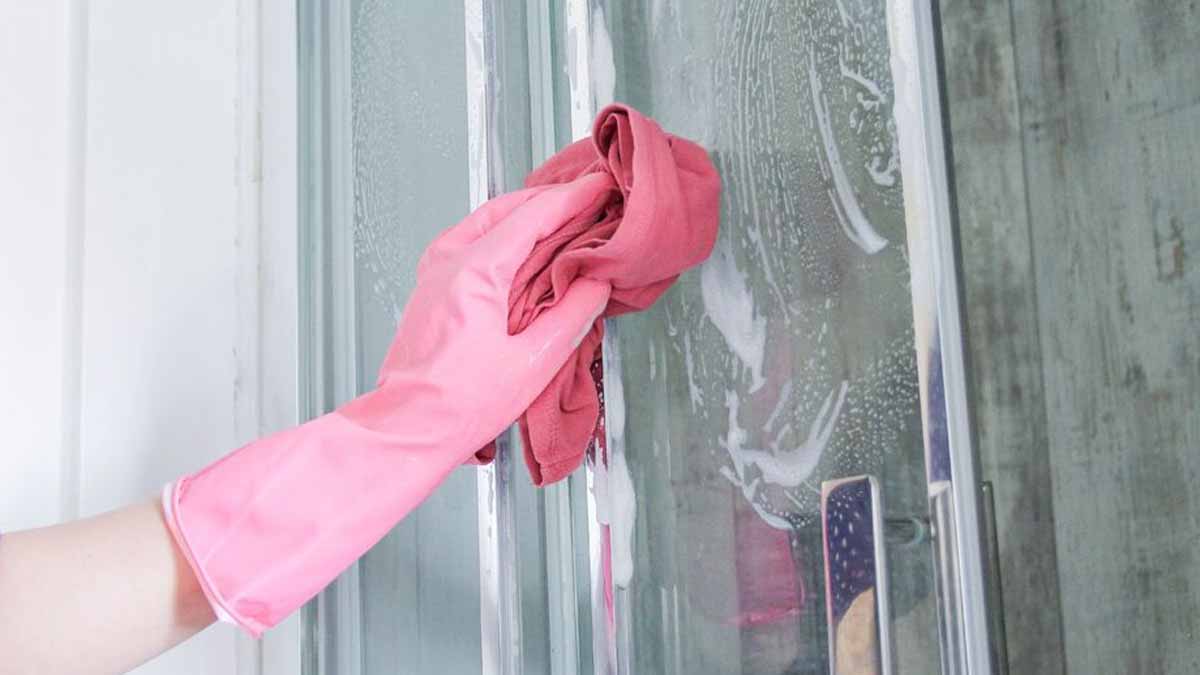Hard water fogs the glass, soap film dulls the shine, and one wrong habit can scar the surface for good. Shower screens show every mark, so small choices matter early. In homes with mineral-rich water, deposits set fast and resist gentle wipes. Regular care beats heroic scrubs, because buildup hardens and then clings. A pro’s advice cuts through the noise with one simple pick, shared widely online. Keep the focus tight, keep the glass safe, and keep cleaning strategic, not frantic.
Hard water, soap scum, and the glass they damage
Mineral deposits stick first, then soap binds them, which turns haze into scale. Left alone, both materials mark the surface and create stubborn streaks. Screens look cloudy even after a rinse because residue remains inside tiny pits. That roughness traps more grime later, so clarity keeps fading faster.
Routine matters because prevention is quicker than correction. A squeegee pull after each shower removes beads before minerals settle. Quick wipes reduce soap film, which means fewer deep scrubs later. Consistency saves elbow grease while also protecting seals and metal trims. Small steps stack up.
When buildup wins, strategy beats force. Use a purpose-made descaler, not harsh abrasives, because glass scratches easily. Rinse with warm water to lift loosened film, then dry with a lint-free cloth. Work in sections to track progress and avoid streaks. A methodical rhythm delivers a clean, even finish.
Cleaning often, yet fast: the pro-backed routine
The crowd favorite is a limescale remover designed for bathrooms. The headline guidance is blunt: “Forget everything else.” Apply a line across the top edge, then another across the middle, because gravity helps spread contact. Gloves protect skin while a damp cloth moves the product uniformly over the pane.
Allow a short dwell so deposits soften, while still avoiding long exposure that risks marks. Wipe the first panel you coated, rinse it well, and watch the haze drop away. Repeat on side glass so the result looks even. This sequencing prevents drying lines, which often cause streaks.
Users praise the clarity because the formula targets scale and watermarks at once. A pro cleaner reports fast, repeatable results in client homes. She pairs product control with a firm rinse so residue cannot redeposit. For daily upkeep, quick passes keep momentum, and cleaning takes minutes, not hours.
Safety, surfaces, and smart habits that protect your bathroom
Match the product to surfaces because bathrooms mix materials. This descaler suits glass and many finishes, including chrome, stainless steel, ceramic tiles, and certain plastics. Always spot-test discreetly first so you check for reactions. Rinse metal taps thoroughly, since acids can dull a shine if they linger on trim.
Airflow matters as much as chemistry because fresh air reduces vapors. Open a window or start the extractor while you work, which keeps the room comfortable. Keep children and pets away until every surface is rinsed and dry. Shorter dwell, steady wipes, and ventilation together reduce risk while improving outcomes.
Fragrance preferences shape choices. Some suggest white vinegar for scale, yet its scent puts people off. When the nose says no, stick with commercial options that address both scale and marks. Read labels so you avoid long contact times. Plan your cleaning path first to prevent pauses and overexposure.
Cost, voices, and timing that make cleaning results repeatable
Demand signals matter when advice spreads online. One post asking for help with water marks drew more than 80 replies. Commenters converged on the same descaler, which supports its real-world usefulness. One user even treats the glass before showering and then rinses mid-shower for “perfect results,” which saves time.
Price also encourages consistency. A typical bottle costs around £1.50 in many supermarkets, which lowers the barrier to regular use. Because the formula removes scale and watermarks together, you buy once and solve two linked problems. Budget left over covers squeegees, cloths, and spare gloves, which keeps momentum strong.
Technique shortens labor. Draw two narrow lines of product as guides so coverage stays even. Because you rinse the first panel first, you avoid drying edges. That process also trains your timing. When a step feels natural, people repeat it, which makes better habits automatic and keeps screens clear.
Alternatives, weekly rhythms, and small tweaks for lasting clarity
When aroma rules out vinegar, choose mild daily aids. A microfiber cloth lifts film while it’s still fresh, so you avoid scouring later. A water-repellent spray reduces spotting between deep sessions. Use sparingly to prevent buildup. Balanced tools protect seals, door runners, and silicone, which often crack under harsh scrubs.
Fit a squeegee hook inside the enclosure so the tool is always within reach. Because friction is low after a hot shower, one slow pull removes beads before they set. On weekends, run a deeper pass that targets edges, hinges, and tracks. That rhythm supports clarity while also extending hardware life.
Adapt to water hardness. In very hard areas, shorten gaps between deep passes. Softeners help the whole home, while filter heads reduce droplets on glass. Keep cloths clean so they don’t redeposit film. With steady attention, you’ll finish cleaning quickly because nothing has time to stick, stain, or scratch.
Practical next steps for clearer screens without harsh habits
Keep your method simple while your timing stays tight. Start with fresh air, test small, and then trace two thin application lines. Wipe in smooth arcs so the film lifts cleanly. Rinse right away, dry well, and step back before moving on. Because clarity rewards consistency, cleaning becomes a calm routine.
